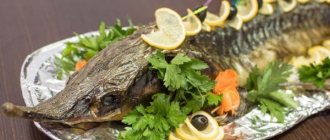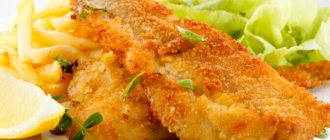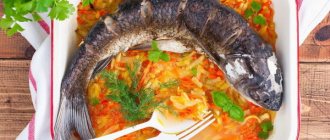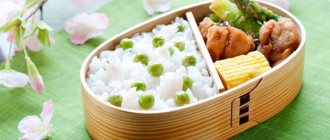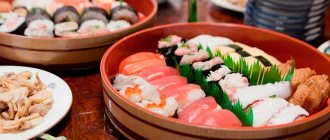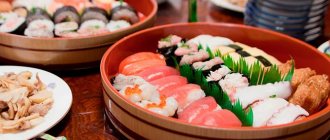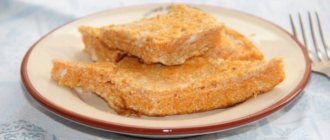The impact of isolation on Japanese cuisine
Since Japan is an island state, which at some times was closed to the political and cultural influences of other countries, it has multiplied and preserved its traditional characteristics until the present day almost unchanged.
The basis for the original development was rice, green tea, noodles, fruit trees, soybeans, borrowed from China, the use of chopsticks and a branch of Zen Buddhism, which was intertwined with the native Japanese religion of Shinto.
A wide variety of seafood has been available on the islands since time immemorial. Peasants also engaged in cattle breeding and agriculture.
Worship of natural forces and contemplation of the beauty of the surrounding world were reflected in the aestheticization of meals and turned it into a beautiful ceremony. Food began to correlate with the seasons and change with the seasons, like the composition of a tokonoma.
Characteristic table traditions have also developed:
- the obligatory wish of “itadakimasu” by all family members before eating as a thank you to the gods for the food;
- “gotisosama” is a similar “thank you for the treat” at the end of a meal.
It is not customary to eat alone - the Japanese wait for everyone to gather.
Drinks are refilled for each neighbor. Chopsticks (hashi) are placed on a special stand next to you when not in use.
Holding them in your fist is a sign of aggression and hostility, as is waving them when talking, leaving them stuck in a dish or crossing them on the table or dishes. Japanese hashi differ from Chinese ones in having thinner ends, which make it easier to catch pieces of fish.
Influence of China and Europe
Their Chinese neighbors had a significant influence on the formation of the taste preferences of the Japanese. Soybeans and green tea were imported from there.
The barbarian Europeans introduced the inhabitants of the islands to meat. Although, at first they lost consciousness from the smell of beef, they were so disgusted with destroying a living creature. But this soon passed and meat received the status of a familiar product. Archaeologists have found special three-meter holes in the ground, which the islanders used as a refrigerator, storing meat there. It was smoked and preserved with salt.
Main features of Japanese cuisine
Unlike European traditions, in Japan the taste qualities of products are not distorted, but are preserved intact or emphasized with appropriate sauces.
Hence, the menu contains so many raw ingredients or lightly processed ones, just enough to preserve their beneficial qualities as much as possible. Often raw fish can be served almost untouched. One of the most unusual features for Europeans is small portions. Chefs focus on variety, the ability to enjoy different tastes without becoming oversaturated. In addition, it is convenient to take small pieces with chopsticks. They are not cut or bitten, but dipped into sauces and immediately placed in the mouth. This is the only way to fully enjoy the taste of the dish.
Broths can be drunk or eaten with a spoon.
It is customary to drink broths, although some soups may be served with a wide ceramic spoon.
The main traditional drinks are green tea and sake (rice wine). Japanese chefs know how to skillfully cut vegetables. They are used for garnish or decoration. Often, the decor of dishes includes stylized images of animals, funny emoticons or anime characters.
There is no concept of a main dish on the menu - each complements and emphasizes the taste of the other. Food is taken in random order. Everyday lunch consists of rice, soup, vegetables, fish or seafood and tea. Delicacies and several types of soups are added to the festive meal, everything is beautifully and carefully decorated and served.
Unlike China and Korea, Japan traditionally rarely eats animal and poultry meat and dairy products. This was influenced by Buddhism. All necessary amino acids are included in the diet through the consumption of legumes (soy), fish, shellfish and crustaceans.
Food in restaurants is often prepared right in front of visitors, and in some establishments there is even the opportunity to directly participate in this sacrament.
The second grain of rice. What do they prefer to eat and what?
For a typical Japanese, a good rest means eating and drinking well. Therefore, the dishes here are varied. They are mainly made from rice, a wide range of seafood, meat, soy and its derivatives. Due to the fact that Buddhism is widespread in Japan, for a long time meat was not a frequent guest on the menu of the average Japanese. Now the situation has changed and the world famous marbled beef is grown in the Hida and Kobe regions.
The Japanese eat with chopsticks, even soup. But initially they were used only at the time of preparing food; during the meal itself, food was taken with hands.
It is known that in Japan many people die every year from poisoning, the reason for this is the love of Fugu, a fish that must be cooked correctly so as not to be poisoned. Chefs are even issued licenses for this activity. A type of fugu has already been developed that is safe for consumption and cheaper, but restaurants still offer a poisonous variety, since the euphoria from its proper preparation and eating is incomparable with the safe alternative.
Further - more about sushi, beloved in Russia, and the true Japanese Jiro Ono.
Useful properties of Japanese food
The country has a record number of centenarians, the reason for which is a moderate, natural and predominantly plant-based balanced diet.
Japanese cuisine is a moderate and natural diet.
The vitamins contained in vegetables are not destroyed by long-term heat treatment and have a general strengthening effect on the body, supply it with all the necessary minerals, maintaining the condition of hair, nails and skin, and increase attention.
This is a good source of fiber, which prevents diseases of the cardiovascular system and cleanses internal organs of toxins.
Polyunsaturated fats, which are found in fatty fish and algae, fight aging and improve the functioning of internal organs and the brain. Hormone-like substances are synthesized from them, which regulate processes associated with blood clotting and have anti-cancer and anti-inflammatory effects.
Become special
Traditional Japanese recipes may seem unusual and different from other Asian dishes. Minimal heat treatment, fresh food, small portions, etiquette - a brief description of recipes for preparing Japanese cuisine.
Preserving the original, natural properties of the product is the main skill of Japanese chefs. Not to create, but to find and discover is the most important commandment of kitchen masters. But to prepare Japanese cuisine at home, you don’t need any special skills or professional kitchen equipment.
Main ingredients
The basic products in Japanese cuisine are the same, but the resulting dishes are richer and more interesting than in neighboring regions.
Seaweed
Japan is the world leader in seaweed consumption. This is a healthy and mineral-rich plant that can be added to almost any dish, including desserts and tea. There are more than 30 edible types, but the most popular are wakame, nori and kombu. They are most often sold dried, but when soaked they quickly take on the appearance of fresh.
Seaweed is a healthy and mineral-rich dish.
Nori is used mainly for wrapping rice or in crushed form for seasoning. They go on sale in the form of thin sheets, sometimes fried and salted. When in contact with water, these algae become very stringy.
Wakame is a long, green or brownish seaweed with a mild and salty taste that is added to salads and soups. They contain a record amount of calcium.
Kombu is used to make broth with the specific smell of the sea. It is seasoned with stewed vegetable dishes, boiled rice, and used as an analogue of kombucha.
Fish and seafood
Since time immemorial, seafood such as raw fish, seaweed and shellfish have formed the basis of the diet of the inhabitants of this island nation. The seas and oceans washing it gave the Japanese about 10 thousand edible items. According to statistics, 1/6 of the world's marine fishing comes from Japan. The most popular traditional dishes contain meat from shellfish, octopus, crab, eel, perch, tuna, trout, salmon, saury, and fish caviar. It is believed that predominantly sea food contributes to the longevity of the nation.
Soybeans
It was brought to Japan from Korea in 500 BC. e. The Japanese still consume soy products daily. Tofu cheese, soy milk, meat analogues, steaks, and miso paste are made from soybeans. It is sprouted, fermented, and boiled. The protein content in some varieties reaches 50%, and cholesterol is completely absent.
In Japan, soybeans are sprouted and boiled.
Rice
It is the basis of most traditional dishes.
A huge number of varieties are grown in Japan, the main ones in the kitchen are white (polished) and brown (shelled). To germinate the latter and care for it, specific conditions are required. Fields with such rice are flooded with stagnant water, which is removed only before the crop has fully ripened. The grain is a hypoallergenic product because it does not contain gluten. It contains a record amount of B vitamins, essential minerals, iodine and amino acids. It is used as a side dish as a substitute for bread.
Sometimes it is fried or steamed, but more often it is simply boiled. Rice is used to make vinegar, starch, mirin wine and sake.
Various vegetables
Plant-based ingredients are an integral part of the kitchen.
The most common are Chinese cabbage (eaten raw or pickled), eggplant, cucumber, leek (used in most cooked dishes and broths), potatoes, carrots, turnips, and spinach. Among the most specific:
- coltsfoot (Akita huki);
- lotus root (roasted);
- gobo, or burdock (it is used for salads, broths, cookies);
- leaf daikon (dried or pickled).
Chinese cabbage is the most common.
Horseradish
The more common name for Japanese horseradish is wasabi, or mustard green. This plant prevents the formation of blood clots and the growth of bacteria. Tempura is prepared from the stems and flowers and added as a seasoning. Since real wasabi requires special temperature conditions and running water, this greatly complicates mass cultivation and increases costs.
It is more popular to use its cheaper analogue - pureed ordinary horseradish with dye and flavoring.
Gastronomic history
The Japanese have always had the opportunity to use a large number of plant and animal ingredients in their cuisine. Vegetables, seafood, and rice have been on the table for a long time.
You will be surprised, but Japanese culinary history did not begin with rice. It appeared only in the 3rd century. Before him, pumpkin, buckwheat, millet and other edible crops were grown. Rice emerged as a national product somewhat later.
White grains became not only the main dish of the Japanese table, but also a monetary measure. Almost until the 19th century, samurai were paid in rice. And a person was considered richer the more bags of rice he had in his house. A lot of time has passed, but rice is still a staple and an ingredient in many dishes.
Traditions of Japanese cuisine
Japanese food is strongly distinguished by the way it is served.
There are no tablecloths on the tables, there are no forks, knives and spoons familiar to Europeans. Often before eating, wet warm towels are brought to dry your hands. Food is served on wooden trays, where sushi, rolls and some other dishes are placed. Plates are used, but for more fluid and crumbly dishes. They can be different in shape and even divided by partitions into several containers, including a gravy boat.
In Japan there are no tablecloths on tables.
Special miniature stands are required for chopsticks, often beautiful and interesting in design. A large pot of tea is brought at the very beginning, and not at the end of the meal. In Japan, they adhere to the belief that each product reveals its maximum taste in its season, when the young animals ripen or appear. Therefore, the seasonality of food is especially noticeable.
When a plum blossoms, the dish is decorated with a flower or branch, and the symbols of flowering are reflected in the color scheme or pattern of the dishes, the shape of the cut or the decor. Bamboo shoots and grains are associated with spring and are served primarily at this time of year. Grilled eel is traditionally prepared in the summer heat. Winter is the time of tangerines, apples and persimmons. Pickles, carrots, cabbage and root vegetables appear on the table. Sake is often served warm and in narrow jugs.
There were sushi - they became sushi
Let's turn to everyone's favorite, sushi. The story here is interesting. The Japanese eat them in a completely different form than we are used to. Many people call this dish “sushi” - the fact is that the sound in the word is close to the soft combination of “cabbage soup”.
They say that this dish is associated with one interesting fact from the history of Japanese cuisine. Sushi in Japan was made like this: fish and rice were used as filling, everything was wrapped in nori seaweed. But one day, the cook of a Californian Japanese restaurant noticed that customers did not like nori and therefore rarely eat sushi. And he simply swapped the filling and the shell, hid the seaweed inside, added a piece of avocado, wrapped everything in rice and fish. This is how modern rolls turned out. I think this is very plausible, because... The Japanese taste is very unique, and it also manifests itself in interesting Japanese delicacies. For example, for the first 2 years I couldn’t eat Japanese miso soup, it didn’t suit me at all, but over time I got used to it.
National and popular dishes
A Japanese table cannot be imagined without the following dishes.
Onigiri
The name translates to “to squeeze,” which reflects the amazing ease of making onigiri. This most popular dish of unleavened rice for snacks or picnics has the form of small balls, pyramids or flat triangles. The filling can be placed inside or added to the rice itself.
Onigiri is a Japanese dish made from unleavened rice.
The molded lump is wrapped in a sheet of nori or pressed with flat seaweed on one side so that it is comfortable to hold and does not get your hands dirty. There are recipes for onigiri fried in oil. The internal filling can be anything - there are no restrictions. It is not advisable to use mussels, as they do not taste well with rice.
Spicy eggplant
Japanese eggplants are early ripening and high-yielding; they differ from the usual ones not only in taste, but also in shape: it is cylindrical, more elongated and narrow. The variety is almost not bitter, cooks quickly and is therefore so popular in cooking. Eggplants are fried (including grilled) and boiled.
Serve them with miso paste, soy sauce, sprinkle with ginger, garlic, hot pepper and chopped onion, using as a side dish or appetizer.
Salad with ginger and carrots
The benefits of this side dish are difficult to overestimate. Young ginger and carrots contain the maximum amount of vitamins. This dish improves vision, memory, lowers cholesterol, and speeds up metabolism. This traditional Asian salad is quick and easy to prepare. Just wash, grate the carrots, ginger root, add salt and honey. For dressing you can use lemon juice, oil, mayonnaise.
Salad with ginger and carrots contains many vitamins.
Pickled daikon
In Japan, it is widespread to include dishes with daikon (a white, elongated radish without the bitterness characteristic of the root vegetable) in the diet.
In pickled form, it is used as a cold appetizer, in salads, and rolled into rolls. It goes well with both meat and fish. Daikon is cooked overnight in rice vinegar with the addition of sugar, salt, turmeric, cloves and pepper. Garlic and bay leaf are also added there. The marinade is transferred to a clean container and placed in a cool place. It can be stored for no more than 2 weeks.
Ramen soup
This dish traditionally consists of noodles in a broth, most often cooked with fish or seaweed, and a side dish. The noodles themselves are prepared from wheat flour, salt, drinking and alkaline mineral water, due to which they acquire a yellowish tint. Miso paste, soy sauce, salt, vegetables, onions, ginger, garlic, etc. are added to the broth.
Ramen soup consists of noodles and side dishes.
To enrich the taste, use boiled eggs, tofu, mushrooms, poultry or beef, and herbs. There are a huge number of varieties of ramen; each region has its own recipes. The dish is served in a wide bowl. First, they eat the noodles and side dish, and drink the broth over the edge or use a spoon for this.
Takoyaki
This dish is treated more like fast food. This is a traditional appetizer made from boiled octopus inside a dough. It looks like fried donuts. Sometimes they put cheese in the dough, and onions and ginger in the filling. Takoyaki is prepared in a special frying pan with semicircular indentations.
They are served hot, several pieces at a time, seasoned with sauce, mayonnaise and always sprinkled with tuna flakes.
Karaage
This is the name given to a cooking technique in which meat, vegetables or fish are marinated in a sauce, then sprinkled with flour and fried in a large amount of oil until golden brown. Most often, chicken is prepared this way, using the boneless thigh part. The dish is always served with Tabasaki, soy or other sauce (depending on the region of preparation).
Karaage is a Japanese way of cooking.
Yakitori
This is a popular dish similar to kebab. Translated it means “fried bird”. They cook it over coals, but use bamboo skewers, not iron. Pieces of meat, entrails (stomach, liver, heart), skin are poured with tare sauce, garlic or onion is added and fried until tender, served with lemon juice and salt. Sometimes the same name is given to pork, beef, seafood or vegetables prepared in a similar way.
Sushi and rolls
Sushi is the national dish of Japan and is popular all over the world.
It has a huge number of types, interpretations and forms of presentation. The main ingredients are glutinous round rice with vinegared rice seasoning, added salt and sugar, and seafood in various combinations. Originally pickled fish was used in the 19th century. it was replaced with a raw one. Traditional fillings include caviar, salmon, tuna, shrimp, crab meat, yam, tofu, cucumber, and avocado. The dish must be served with pickled ginger, soy sauce and wasabi (to disinfect raw seafood). The main types of sushi differ in the way they are wrapped in a sheet of dried seaweed - nori.
Sushi and rolls are the national dish of Japan.
Nigiri is hand-pressed rice with a small amount of wasabi and a thin filling, which is placed on top and a thin strip of nori is wrapped around the rice.
Gunkan-maki - similar to the previous option. It is also sculpted by hand, but nori is wrapped around the entire perimeter, giving the rice the shape of a floating boat.
Makizushi, or roll, is a softened sheet of nori rolled using a bamboo mat with rice and filling, which is then cut into cylinders and served in 6-8 pieces.
Temakizushi is a sheet of nori rolled into a cone shape. Such sushi resembles a cornucopia. They are quite large, up to 10 cm in length. They eat them with their hands.
Uramaki is distinguished by a combination of several fillings. The nori in which the filling is wrapped is located inside the rice. The outside of the rice can be sprinkled with caviar, tuna shavings or sesame seeds.
Chirashizushi is a close European presentation of the dish. Without shaping the rice, they simply pour it into the bowl and place the filling on top.
sake
The second name for this drink is rice wine or rice vodka, which is not entirely correct, since this is the general name for all drinks containing alcohol.
And the one that is implied is called nihonshu in its homeland. This is a traditional alcoholic drink based on rice and malt, produced by mold fermentation. Its strength is 15-20%. The taste shades are very different - from fruit to mushroom. Color saturation and transparency also vary greatly. Varieties - from the cheapest and tasteless to the elite and noble. Table types of sake are served warmed up, but a high-quality drink is always drunk chilled.
Yakiniku
Initially, this meant meat (beef, pork or entrails) that was fried on a grill over coals, but later it began to refer to vegetables and other foods prepared in the same way. This is the Japanese equivalent of barbecue.
Yakiniku is meat that is grilled over charcoal on a grill.
Restaurants often have electric or gas grills built into their tables. So you can prepare the dish yourself and to your taste while chatting with friends or companions, ordering all the necessary raw ingredients. Special ventilation systems clear the room of smoke, leaving the air clean. The yakiniku comes with tare sauce and appetizers.
Curry
This dish is based on curry sauce, which is used as a dressing for boiled rice or noodles.
It is quite thick and spicy in taste. There are meat and vegetarian varieties. Traditionally, it is prepared from vegetables and beef, which are lightly fried, poured with broth and simmered until cooked. Then add flour and curry powder, which includes the following seasonings: turmeric, garlic, mustard, cumin, ginger, cardamom, nutmeg, cloves, black pepper, coriander, chili pepper. Most often, ready-made semi-finished products are purchased for the sauce and only restaurants prepare all the ingredients themselves.
Soul rice
You probably remember that rice is not just food for the Japanese, but a huge value. The meal is not over unless rice is served. Previously, the inhabitants of the country of sakura and chrysanthemums believed that rice had a soul, like any person. Anyone who treats him with disrespect will get trouble in return. They even have a rice deity - Inarishima. According to legend, it was it that brought rice to the Japanese, and not Chinese merchants. By the way, they only eat rice grown in their homeland, and in fact it is very different from the one we are used to - the grains should be whole, white and shiny, small grains are a sign of poor quality and, accordingly, cost less. As a rule, this is this year’s harvest (of course, in winter and summer, last year’s is consumed, until the new harvest). On average, 10 kg of good cereal costs 3000-4500 yen (sometimes cheaper, but also more expensive).
Japanese food recipes
Some dishes with ingredients available for purchase in any supermarket can be successfully prepared at home.
Teriyaki beans
This recipe uses green beans and teriyaki sauce. You can add chicken or turkey fillet to the classic interpretation. Frozen green beans are not hard to find, but you can substitute a cup of white or red beans or a mixture of both.
Teriyaki beans take several hours to cook.
Required ingredients:
- beans - 150 g or 1-1.5 tbsp.;
- sesame oil - 1 tsp;
- refined vegetable oil - 50 ml;
- sesame seeds - 1 tbsp. l.;
- brown (cane) sugar - 80 g;
- ginger powder - 1 tsp;
- corn starch - 2 tbsp. l.;
- onion - 1 pc.;
- sweet pepper (red) - 1-2 pcs.;
- vinegar (preferably rice) - 1 tbsp. l.;
- corn starch - 2 tbsp. l.
Cooking sequence:
- First, the beans (dry) are washed and soaked for several hours (can be left overnight).
- Wash it again, fill it with fresh water and cook over low heat.
Teriyaki sauce is prepared as follows:
- All remaining ingredients, except starch and sesame seeds, onions and peppers, are poured into water.
- Stirring, bring the mixture to a boil and cook for several minutes, after which starch diluted in a small amount of water is gradually poured into it.
- Bring the mixture to the desired thickness and add sesame seeds.
- Lastly, prepare the onions and bell peppers, cutting them into thin slices and frying them in oil in a frying pan.
- Place the cooked beans in the same frying pan and simmer for several minutes in a small amount of broth with teriyaki sauce.
The entire mixture must sit covered for 10 minutes. Then you can serve the dish to the table.
Seaweed soup
There are a huge number of types of this dish, as well as the types of seaweed themselves that are used in Japanese cooking. Depending on the main ingredients, soups go by a variety of names. Seaweed is added to most soups with rice, wheat noodles, crab, fish, soba, tofu, spinach, kimchi, etc.
Seaweed is added to soup with rice.
Miso soup is one of the most popular among many consumers, ranking alongside traditional sushi and sake.
The broth for it is boiled using empty water and seaweed, so it must be fresh, otherwise its taste will be lost.
For the recipe you will need:
- tofu cheese - 200 g;
- seaweed (wakame, nori or kelp) -150 g;
- miso paste - 4-5 tbsp. l.;
- green onion feathers - 1-2 pcs.;
- water - 1000-1200 ml.
Prepare the dish according to the following recipe:
- Tofu is cut into cubes weighing approximately 5 g.
- Pressed seaweed (or pre-soaked in water) and cheese are added to water brought to a boil, but not boiling water. The seaweed should not be boiled, otherwise the broth will turn out bitter.
- Pour in the pasta diluted in boiling water in another container and immediately turn off the heat. The paste is not boiled to avoid insoluble lumps.
The soup is ready. You can pour it into bowls and garnish with chopped onions.
Mochi
Since rice is the main component of Japanese dishes, they have learned to make desserts from it.
Mochi is made from special rice.
Thus, mochi is made from a special type of rice - mochigome, which, when ground and wet for a long time, becomes sticky and sweet. It is used as a dough for making rice sweets. They are usually given as gifts for the New Year and served at the festive table.
You can prepare a similar dessert in the form of traditional round cakes with filling yourself.
Ingredients for the base:
- rice flour - 300 g;
- powdered sugar - 100 g;
- natural dyes - 2 g;
- corn flour or starch - 100 g;
- water - 300 ml.
It is advisable to use natural fruit or berry juice as a dye.
Prepare mochi like this:
- Mix flour and powdered sugar in a convenient container, adding colored water.
- Cover the resulting homogeneous mass with cling film and place in the microwave (for 1-2 minutes) or heat in a water bath until thickened.
- If after mixing the result is unsatisfactory, repeat the procedure with heating.
- Sprinkle the resulting dough with starch and place it on the surface for further processing: rolling out and cutting out shapes.
- Place the filling in the center of the flat circles, pinch the edges together and roll into a ball or round cake, sprinkling with starch so that the dough does not stick to your hands.
- After cooking, serve immediately.
You can use a variety of fillings, including berries, chocolate, caramel, and cookies.


